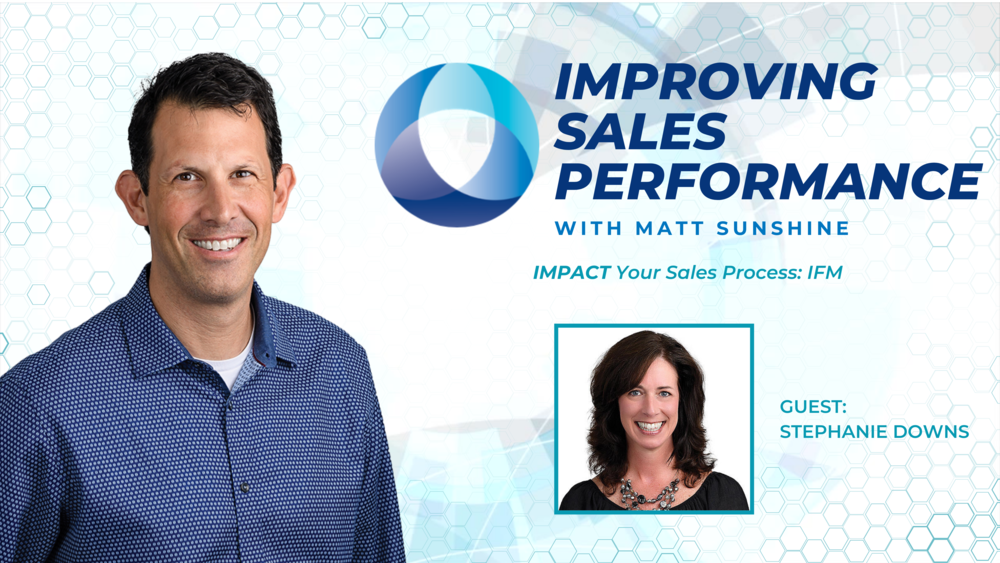
1-on-1 meetings play a large role on your team’s sales performance.
In this episode, Stephanie Downs, VP and Senior Consultant, discusses how sales leaders can make an impact on their sales process with 1-on-1 meetings, or what we call the IFM. Plus, she covers the fundamentals of IFMs and how you can turn this dreaded weekly task into productive meeting.
Tune in now to hear the Live broadcast or keep reading for a brief overview.
What is the Purpose of 1-on-1 Meetings?
At the Center for Sales Strategy (CSS), we refer to 1-on-1 meetings as Individual Focused Meeting (IFMs). Regardless of what you call these meetings, it’s the prime time and opportunity to talk to your salespeople about their biggest and best client’s and prospects.
The IFM has a very distinct purpose and structure.
An IFM is an opportunity for you and your salespeople to focus on activities that will help them move prospects and large clients through their sales pipeline. A great IFM will motivate your reps and provide concrete next steps for both their top prospects and best clients.
Why Do Most Salespeople and Sales Manager’s Dread 1-on-1 Meetings?
It’s no secret that these weekly meetings are a dreaded task for both sales leaders and salespeople. But, why?
Downs answers this question by saying, “Managers have the wrong mindset. They think it’s too time intensive. They’re thinking about it from a time commitment versus the intent of meeting.”
As Sunshine point out, many sales leaders have the mindset of “I have to” versus “I get to.”
Downs continues explaining why salespeople often dread 1-on-1 meetings, “From a seller’s perspective, they just don’t see value in the meetings because the meetings are not set up right. They don’t have the right agenda and the manager is not focusing on the right topics.”
Managers tend to use 1-on-1 meetings as a, “what’s in your pipeline” or “what’s pending” type of meeting, and salespeople don’t find value in that, so it’s frustrating for them.
Top-performing sellers look forward to their weekly IFM because they see value in:
- The process: Managers can help them get over the hump and overcome sales obstacles.
- The time: 45-minutes to one hour a week in exchange for ways to grow revenue delivers great ROI.
- The accountability: Top-performing sellers enjoy accountability when it leads to bigger commission checks.
- The focus: Uninterrupted time with a quality manager is a beautiful thing!
The Fundamentals of IFMs
There are five primary components related to IFMs:
- How often
- The prep
- The environment
- The agenda
- Recap
Tune in now as Downs and Sunshine deep dive into each component!
How Often Should You Have 1-on-1 Meetings?
Downs suggests having 1-on-1 meetings with your salespeople weekly or bi-weekly. These meetings should last 45-minutes to one hour – no shorter.
“If you have a senior AE with more of a transaction list, or they’re just superstars at developing new business, a bi-weekly meeting for them is probably okay,” she explains. “If you have someone that’s newer, or needs a more constant touch-point, then weekly is best. If someone is brand new – maybe even more often than that.”
How Do You Prep for 1-on-1 Meetings?
Downs says you want to start prepping with the recap from the last meeting. “As the salesperson, you want to give an update. As the manager, you want to make sure that you’re asking the right questions.”
She also suggests for sales managers to think about the positive thing(s) that they want to recognize early in the meeting. For example, did the salesperson close a piece of business? Did they get a meeting with a Target Account?
“Recognize something they’ve accomplished since the week prior,” she states. “If you’re a CSS client, you have access to the talent instrument — STA—you always want to go back and revisit that prior to the meeting. The priority coaching strategies show you what you should focus on and how can you get the most out of that salesperson. Plus, you want to look at their Growth Guide as well.”
As a seller, Down advises that you read the recap and come prepared with your weekly sales plan to discuss the target accounts or the key accounts. Also, come prepared with any questions or ideas that you have related to your keys or target accounts.
The entire prep should take a maximum of 15 minutes.
Where Should 1-on-1 Meetings Take Place?
The environment for 1-on-1 meetings depends on whether you’re conducting business face-to-face or remotely.
 If you’re operating face-to-face, Downs says that holding the meeting in an office is fine but sit alongside the salesperson, not across the desk. “Sitting across the desk can feel a little like interrogation. It’s uncomfortable and not as open of a dialogue or conversation.”
If you’re operating face-to-face, Downs says that holding the meeting in an office is fine but sit alongside the salesperson, not across the desk. “Sitting across the desk can feel a little like interrogation. It’s uncomfortable and not as open of a dialogue or conversation.”
If you’re still on a remote schedule, Downs suggests sharing your agenda on the screen so you both are staying on track and on task. “Be a coach and a contributor in the conversation. Don’t talk at the salesperson, or tell them what to do, pull them into conversation and coach them through the next steps.”
Regardless of where the meeting takes place, be respectful of each other’s time. Close emails, turn off phones and meeting chats. As a sales manager, this time is about helping your salesperson, and you want to be completely focused.
1-on-1 Meeting Agenda
The agenda for an IFM should primarily focus on quality activity. Here’s a quick breakdown of how the agenda should look:
- 5 minutes to celebrate successes.
- 5 minutes to review key actions from the previous week (recap), and see what the next steps are.
- 10-15 minutes discussing Key Accounts.
- 20-30 minutes reviewing Target Account development
- 5 minutes spent on wrap-up.
Every IFM will look different, however, it’s important to keep your agenda consistent every week. “Seller’s need to know what to be prepared for next week,” explains Downs. “1-on-1 meetings are about account development.”
Recapping a 1-on-1 Meeting
First, you need to decide who is sending the recap – the sales manager or the salesperson. Once this is determined, it needs to stay consistent.
“It shows a level of engagement if the seller sends the recap because you’re sure they’ve heard you, and know what you’ve discussed and the next steps,” explains Downs. “However, if the seller is not buttoned-up on details, the manager should send it.”
The recap of IFMs should be short and sweet and sent within 24 hours of the meeting. It should include two or three key action items and identify the next steps.
The Impact Leadership System has a course dedicated to IFMs. If you’re a CSS client, login to the Resource Center, select Impact Leadership System Training under Online Learning, and the course is under Process.
If you’re not a CSS client, you can sample courses at css.buzz/IMPACT.
Don’t miss another episode of the Improving Sales Performance series where Managing Partner Matt Sunshine speaks with thought leaders, experts, and industry gurus, who share their insight, tips, and knowledge on various topics that help companies improve sales performance.
Subscribe to our YouTube channel, and have your notifications on so you’re notified of our next episode!



